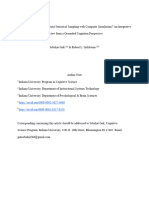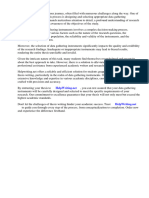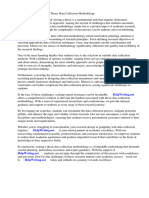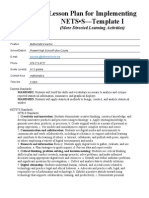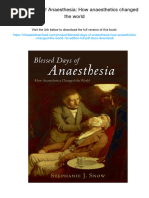0 ratings0% found this document useful (0 votes)
45 viewsMted 5320 Final Paper
Mted 5320 Final Paper
Uploaded by
api-255031842Copyright:
© All Rights Reserved
Available Formats
Download as DOCX, PDF, TXT or read online from Scribd
Mted 5320 Final Paper
Mted 5320 Final Paper
Uploaded by
api-2550318420 ratings0% found this document useful (0 votes)
45 views14 pagesOriginal Title
mted 5320 final paper
Copyright
© © All Rights Reserved
Available Formats
DOCX, PDF, TXT or read online from Scribd
Share this document
Did you find this document useful?
Is this content inappropriate?
Copyright:
© All Rights Reserved
Available Formats
Download as DOCX, PDF, TXT or read online from Scribd
Download as docx, pdf, or txt
0 ratings0% found this document useful (0 votes)
45 views14 pagesMted 5320 Final Paper
Mted 5320 Final Paper
Uploaded by
api-255031842Copyright:
© All Rights Reserved
Available Formats
Download as DOCX, PDF, TXT or read online from Scribd
Download as docx, pdf, or txt
You are on page 1of 14
MTED 5320
Tinkerplots and the Development of Quantitative Reasoning
Jose L. Bautista
The University of Texas at El Paso
Table of Contents
MTED 5320 .................................................................................................................................... 1
Introduction ..................................................................................................................................... 1
Advantages of Tinkerplots .............................................................................................................. 3
The Need ......................................................................................................................................... 5
Teachers Roles ............................................................................................................................... 7
Data based Inquiry .......................................................................................................................... 9
Problem Context ............................................................................................................................. 9
Data Representation ...................................................................................................................... 10
Implications of Using Tinkerplots in the Classroom .................................................................... 10
Bibliography ................................................................................................................................. 12
1
Introduction
Inferential statistical reasoning or quantitative reasoning is a statement about a population or
process that is inferred from a sample, along with an explicit level of confidence. Randomization
is usually introduced to young students (middle school) through chance devices like coins and
dice; however, it is very difficult for students to form a good conceptual understanding of the
activities in which they get engaged during data collection. Traditional pedagogies in which
students learn with "ready-made" mathematical knowledge often leads to students not being
receptive of the mathematical ideas.
Therefore, research in statistics education has deemed necessary to start by generating informal
statistical inferences in students before submerging them in formal statistical methods. This
would be the base in which students would support the development of more formal conceptual
and procedural understandings of statistical inferences at a later time of their lives. According to
a research study (Makar, Bakker, & Ben-Zvi, 2011, p. 152), informal statistical inference is
nurtured by statistical knowledge, knowledge about the problem context, and useful norms and
habits developed over time, and is supported by an inquiry-based environment (see figure 1). The
primary goal is to learn to make sense to form students that are better prepared to use
mathematics in everyday life and to answer any questions that might appear on a standardized
test.
2
Some studies suggest that computer visualization tools can enhance teachers content and
pedagogical knowledge of statistics which can in turn increase students learning (Meletiou-
Mavrotheris, Paparistodemou, & Stylianou, 2009). One of the most useful and known computer
programs used to explore issues associated with developing ideas of informal inference is
Tinkerplots. This computer software has the potential to present students with meaningful
investigations that lead to an appreciation of the types of questions that informal inference can
help to answer. Many of these investigations in which students get engaged could have not been
possible without the use of Tinkerplots and while some of them could, the software package can
save time and add creativity and student ownership to the production of evidence and the
creation of a final report answering the initial questions.
Statistical
Knowledge
Problem
Context
Useful
norms
Problem
Context
Habits
Sense
Making
Informal Statistical Inference
Elements
Inquiry-Based Environment
Figure 1: Informal Statistical Inference Model
3
Advantages of Tinkerplots
The ever increasing technological advances in our society bring also as a consequence an
increasing availability of mathematics education software. It is impossible and would be
negligent to neglect the importance that technology plays among the student population and how
students have learned to embrace technology in their daily lives. Tinkerplots is a dynamic
graphic software created with a constructivist view in mind especially for middle school
students. The software is relatively simple to use, data entry takes place directly using data cards
(see figure 3) or a table, or by importing files from spreadsheets or web sites. Data cards mimic
very closely the data cards that students are familiar with when working collaboratively in their
classroom. Data are first presented in a random fashion in a two dimensional form on the screen,
as can be observed in figure 4.
Figure 2: Example of Data Card
4
Figure 3: Tinkerplots screenshots
Students can create bins from which plots are generated by moving variables, called attributes,
using a drag-and-drop movement to drop the variable into the plot area. Dragging the icons to the
plot left or right creates more or fewer bins. Tools available for interpreting data presented in
plots include reference lines, dividers, hat plots and box plots, group size and percent, median
and mean, and labels.
The value of Tinkerplots as an educational software was evaluated (Fitzallen, 2007) in Australia
in 2007 and found to satisfy the evaluation criteria, which included: being accessible and easy to
use, assisting recall of knowledge and representation in multiple forms, facilitating transfer
between mathematical and natural language, providing extended memory when organizing and
reorganizing data, allowing multiple entry points for abstraction and concepts, and providing
visual representation for interpretation and expression (Watson & Donne, 2009, p. 2).
Also, the use of the hat plot for representational purposes has been found to be and engaging and
easy to use as a tool for data analysis (Watson J. M., 2008). An example of hat plots covering
5
about 50% of the data in the crowns is shown in figure 5. The low 25% and high 25% in the
brims for height data for samples of adult males and females is shown.
Figure 4: Example of hat plots
Tinkerplots allows students to understand beginning inference by exploring what is possible and
what could be possible.
In order for students to develop a data-oriented mindset and good data literacy skills, significant
change must be made to the typical instructional methods employed in the classroom to teach
statistical concepts. The implementation of Tinkerplots as a dynamic software has the high
potential, according to research, to allow students to explore data in ways that had not been
possible for them before.
The Need
The notion that one can use collected and available data to make claims or inferences about the
unknown is the most powerful tool in statistics. Statistics promote the formulation and
6
explanations of real life events or phenomena based on available or collected data. This leads
students to provide explanations that draw on knowledge about statistics on the context being
studied. Difficulties in studying formal statistics courses at a high school or university level have
induced teachers and researchers to explore data analysis with less formal methods with the
intentions to bridge and create a smooth transition between the latter and more formal statistical
inference methods.
The literature is filled with evidence of students difficulties in the area of statistical inference
methods. Traditional mathematical pedagogies usually guide students to obtain right answers
without allowing them to fully understand the mathematical concepts involved. Some studies
attribute that much difficulty for learners arises from the procedural focus given in many
statistics courses and the lack of direction towards reasoning and sense making (Madden, 2011,
p. 111). This is very important because employers very often need people that are capable of
drawing conclusions beyond available data to make judgments in the workplace, often without
formal statistical techniques. However, too often in schools, teachers focus their pedagogical
instruction of statistical learning on the graph, the conclusion, or the computation, but most of
the time the pedagogy employed neglects the part that is involved in sense making. In order to
generate informal inferential reasoning processes, students must be exposed to repeated
experiences with data over time to develop norms and habits of working collaboratively with
other students in an inquiry-based environment. The latter norms serve to induce students to
utilize statistical concepts as tools to seek evidence for the interpretations of data, but most
importantly, the inquiry process should be a sense-making process driven by doubt; this process
will then effectively lead to students giving inferences and explanations.
7
The easy and simple ways in which students can create different arrangements and
representations of the data collected in Tinkerplots, leading to the formulation of inferences,
make this software package a suitable choice for introducing students to informal statistical
inference methods. Research literature in the area of statistics indicates very poor statistical
intuition among most college-level students and adults; however, this is not the result of peoples
lack of intelligence to understand statistics but the deficient learning environments that
characterized our educational system.
Teachers Roles
There is a different issue associated with effective instruction of informal inferential statistics:
teachers who are not really prepared to teach a statistics course and that are not confident in the
level of understanding they possess about the subject. The writer of this report has himself heard
from in-service mathematics teachers that statistics is the most difficult subject to teach and to
understand for them. In one occasion during a graduate class discourse, an in-service teacher
asked a question about the simple relationship of how wide a bell shape is and the standard
deviation. For example, having two similar bell shapes with same mean, one having wider spread
than the other means that the data deviates more on the former than on the latter, just to view it in
very simple terms (see figure 2). This shows that if teachers have trouble having a good
conceptual understanding of formal simple statistical concepts, then it is expected that students
would have more trouble understanding the concepts and even much more trouble making sense
of the statistical methods. Thus, teachers who have limited experiences or have difficulty
understanding statistical processes, appear to fail to understand and appreciate what their
students experience as learners (Watson J. M., 2008, p. 80).
8
Figure 5: Dist. Equal means and Diff. Std. Dev.
Even though, many teachers have experience with professional development courses in
mathematics, many of them do not feel confident when teaching statistics, this creates a negative
effect which does not relate well to the goals of the investigations in which they engage along
with their students. Mathematics teachers are much more effective when they understand their
role as classroom managers to facilitate students professional growth, but they must be fully
prepared and must have a strong conceptual and procedural knowledge of the subject. Preparing
teachers for their roles as managers of the learning environment presents new challenges both to
novices and experienced mathematics teachers. The role of the teachers engaged in informal
statistical inference environments involves a lot more than just presenting the statistics
knowledge and pouring it into the students minds. A key aspect for teachers to be successful in
this field is to be highly knowledgeable about statistics so that they can present the statistical
concepts in a non-traditional manner, with the help of software packages like Tinkerplots. If the
aforementioned conditions are not met, then the learning environment is definitely doomed for
failure because the teacher lacks the problem-solving strategies that students need to be exposed
9
to. Thus, teachers must engage students in problem solving and applying their knowledge to
different situations. Therefore, teachers manage the classroom environment with the ultimate
goal of facilitating students' professional growth.
Being prepared to use technology and knowing and knowing how that technology can support
students conceptual understandings must become integral skills in every teachers professional
repertoire. However, research shows that the adoption of technology in the classroom is strongly
influenced by teachers attitudes and beliefs about technology (Angers & Machtmes, 2005, p.
771).
Data based Inquiry
Inquiry processes play an important role in informal inferential reasoning. In order to understand
how people learn something new, and particularly how students form inferences, it is of extreme
importance that students make sense of the data at hand. Inquiry is a fundamental process in all
human cognition (Makar, Bakker, & Ben-Zvi, 2011, p. 152). The inquiry processes that occur in
students minds are needed to develop reasoning and judgments when drawing conclusions
beyond the available data. This is an important aspect that helps students and their teachers to
make reasonable inferences without learning formal techniques.
Problem Context
Inquiry-based mental processes must derive from the uncertainty or doubt that the problem
context provides. This context allows students to find meaning in observed patterns about the
real situation by weighting up explanations and seeking competing explanations, in other words,
the context forms a connection between the abstract nature of the problem and how it can be
10
interpreted into a story. The use of visual stimulations, particularly randomization tests, in a
dynamical technological environment like Tinkerplots, is very helpful when comparing
distributions. Comparing distributions can serve as a vehicle to support increasingly
sophisticated statistical arguments while investigating characteristics of distributions; measures,
types, and ramifications of variability; and the construction and interpretation of sampling
distributions.
Data Representation
Tinkerplots randomization tests are used to find if certain differences in measures (like the
mean, medians, and other statistics of interest) from the experimental data could be considered
statistically significant. As a pedagogical tool, Tinkerplots provides a representation from which
students can reason about population differences based on samples. Thus, randomization tests
help students decide or infer whether perceived distribution differences are significant.
Tinkerplots provides the conditions to illuminate relationships among distribution, variability,
and sampling and to subject informal inferential reasoning to a more extended scrutiny by
learners sense making.
Implications of Using Tinkerplots in the Classroom
According to several research studies, mentioned in the body of the report, there are strong
indications that support the belief that using Tinkerplots in the statistics classroom can promote
active knowledge construction by encouraging students to build, refine, and reorganize their
prior understandings about statistics. The Tinkerplots software has been designed with young
students in mind, particularly middle school students; it can provide an inquiry-based learning
11
environment. Rather than having students repeatedly practice how to calculate measures such as
the mean and median by hand, instruction should focus on helping them understand how to use
those measures in making comparisons, predictions, and generalizations. Tinkerplots is a useful
pedagogical tool in achieving this purpose. It provides a medium for the design of activities that
integrate experiential and formal pieces of knowledge, allowing students to make direct
connections between the collected data and its formal representations. With Tinkerplots, students
can experiment with statistical ideas, learn to progressively articulate their informal theories, use
them to make conjectures, and then use the experimental results to test and modify those
conjectures.
Therefore, as suggested by numerous research articles, Tinkerplots is an effective software
program for the teaching and learning of early statistical reasoning that forms a strong support
for the more formal conceptual and procedural understanding of statistics in later years.
12
Bibliography
Angers, J., & Machtmes, K. (2005). An Ethnographic Case Study of Beliefs, Context Factors,
and Practices of Teachers Integrating Technology. The Qualitative Report, 10(4), 771-
794.
Madden, S. R. (2011). Statistically, Technologically, and Contextually Provocative Tasks:
Supporting Teachers Informal Inferential Reasoning . Mathematical Thinking and
Learning, 109-131.
Makar, K., Bakker, A., & Ben-Zvi, D. (2011). The Reasoning Behind Informal Statistical
Inference. Mathematical Thinking & Learning, 13(1/2), 152-173.
Meletiou-Mavrotheris, M., Paparistodemou, E., & Stylianou, D. (2009). Enhancing Statistics
Instruction in Elementary Schools: Integrating Technology in Professional Development.
The Monatana Mathematics Enthusiast, 57-78.
Watson, J. M. (2008). Exploring Beginning Inference with Novice Grade 7 Students. Statistics
Research Journal, 59-82.
Watson, J., & Donne, J. (2009). TinkerPlots as a Research Tool to Explore Student
Understanding. Technology Innovations in Statistics Educattion, 1-35.
You might also like
- MOPX 309 Separation System With Build-On PumpDocument38 pagesMOPX 309 Separation System With Build-On PumpBalaNo ratings yet
- Contemporary Issues in AccountingDocument29 pagesContemporary Issues in AccountingMichelle Mcmillan0% (1)
- What Is Descriptive ResearchDocument2 pagesWhat Is Descriptive ResearchRose Marie AringoNo ratings yet
- How Does A Push or A Pull Affect Make Things Move?Document19 pagesHow Does A Push or A Pull Affect Make Things Move?api-296067880No ratings yet
- REVIEW of How Do Students Reason About Statistical Sampling With Computer SimulationsDocument56 pagesREVIEW of How Do Students Reason About Statistical Sampling With Computer SimulationsPsycho ScorpionNo ratings yet
- The Role of Technology in Teaching and Learning Statistics: Dave Pratt, Neville Davies, and Doreen ConnorDocument11 pagesThe Role of Technology in Teaching and Learning Statistics: Dave Pratt, Neville Davies, and Doreen ConnorBernardo SilvaNo ratings yet
- Thesis Data Gathering InstrumentsDocument6 pagesThesis Data Gathering Instrumentszaivlghig100% (2)
- Thesis Data Collection MethodologyDocument5 pagesThesis Data Collection Methodologyafcnwwgnt100% (2)
- CrimmDocument7 pagesCrimmRogers OmurwaNo ratings yet
- FramingissuesassignmentDocument5 pagesFramingissuesassignmentapi-378040954No ratings yet
- Related Studies About Computer Games ThesisDocument9 pagesRelated Studies About Computer Games Thesismichellejohnsoncharleston100% (1)
- Statistics and Probability TGDocument18 pagesStatistics and Probability TGMarissa Almaden CostimianoNo ratings yet
- The Problem and Its BackgroundDocument6 pagesThe Problem and Its BackgroundJesryl Remerata OrtegaNo ratings yet
- Educ3625 Assignment 2b NewDocument8 pagesEduc3625 Assignment 2b Newapi-428315733No ratings yet
- Ainley, J & Pratt, D (2001) Introducing A Special Issue On Constructing Meanings From Data Educational Studies in MathematicsDocument14 pagesAinley, J & Pratt, D (2001) Introducing A Special Issue On Constructing Meanings From Data Educational Studies in MathematicsRicardo NarváezNo ratings yet
- ASSIGMENT 3 Roles of Technologies in Promoting The Scientific LiteracyDocument5 pagesASSIGMENT 3 Roles of Technologies in Promoting The Scientific LiteracyJane JennTiansinNo ratings yet
- PHD Thesis in Information Technology PDFDocument4 pagesPHD Thesis in Information Technology PDFjuliemaypeoria100% (1)
- Concept Paper TemplateDocument5 pagesConcept Paper TemplateJusmine MurilloNo ratings yet
- Statslessonplanems480 HerringDocument15 pagesStatslessonplanems480 Herringapi-439439342No ratings yet
- Computer Literacy Assessment Among The Senior High School of STDocument7 pagesComputer Literacy Assessment Among The Senior High School of STBUMANGOL KHENCHY GOYAONo ratings yet
- Attitudes and Competencies TowardDocument2 pagesAttitudes and Competencies Towardnouar1988No ratings yet
- Geogebra in Teaching StatisticDocument10 pagesGeogebra in Teaching StatisticHAzman Jazimin SaadNo ratings yet
- Student Information System Thesis SampleDocument8 pagesStudent Information System Thesis Sampleowynqovcf100% (1)
- A Guide To Teaching Data Science (Hicks)Document45 pagesA Guide To Teaching Data Science (Hicks)carlosgg33No ratings yet
- Action Research PaperDocument15 pagesAction Research Paperapi-452027841No ratings yet
- Chapter 3 Thesis Statistical Treatment of Data SampleDocument8 pagesChapter 3 Thesis Statistical Treatment of Data SampleWebsitesToTypePapersElgin100% (2)
- The Impact of Digital Technologies On Learning (2012) PDFDocument52 pagesThe Impact of Digital Technologies On Learning (2012) PDFAsmahani AmranNo ratings yet
- Thesis Presentation Analysis and Interpretation of DataDocument5 pagesThesis Presentation Analysis and Interpretation of Dataavismalavebridgeport100% (2)
- Erpr7412 Task 2Document7 pagesErpr7412 Task 2noluhazelnutNo ratings yet
- What We Can Learn From Math AppsDocument19 pagesWhat We Can Learn From Math Appsapi-550243992No ratings yet
- Chapter OverviewsDocument5 pagesChapter OverviewsMary Jane LaraseNo ratings yet
- ResearchDocument21 pagesResearchLanne ChalusNo ratings yet
- Assignment 8614 PDFDocument22 pagesAssignment 8614 PDFSakib Aliyas ShigreNo ratings yet
- The Impact of Using Technology On StudentsDocument27 pagesThe Impact of Using Technology On StudentsFrederick RabangNo ratings yet
- Role of Information Technology in Education System 170605100Document7 pagesRole of Information Technology in Education System 170605100farahdilafNo ratings yet
- Sample Thesis Chapter 3 Statistical Treatment of DataDocument6 pagesSample Thesis Chapter 3 Statistical Treatment of DataPaperWritersForCollegeCanada100% (1)
- THE IMPACT OF TECHNOLOGY FinalDocument17 pagesTHE IMPACT OF TECHNOLOGY FinalAsan BarhamaNo ratings yet
- 4 IDC09-p52-gelderblomDocument9 pages4 IDC09-p52-gelderblomТеодора ВласеваNo ratings yet
- Statistical Tool ThesisDocument8 pagesStatistical Tool Thesislidzckikd100% (2)
- Flrez ChangingGenerationsWay 2017Document28 pagesFlrez ChangingGenerationsWay 2017emmaneulmandebvu04No ratings yet
- Significance of The Study Thesis Grading SystemDocument8 pagesSignificance of The Study Thesis Grading SystemAsia Smith100% (2)
- Name: Yasmin Fatin Binti Dean Class: 5 Bougainvillea I/C No: 951130-08-5350 Teacher S Name: Puan Najihah Binti MustaffaDocument21 pagesName: Yasmin Fatin Binti Dean Class: 5 Bougainvillea I/C No: 951130-08-5350 Teacher S Name: Puan Najihah Binti MustaffaZaim HareezNo ratings yet
- Assessıng Students' Understandıng of Tables and Graphs: Implıcatıons For Teachıng and ResearchDocument20 pagesAssessıng Students' Understandıng of Tables and Graphs: Implıcatıons For Teachıng and ResearchAdeza GuntiaNo ratings yet
- RESEARCH PROPOSAL PUEDAN-tangposDocument12 pagesRESEARCH PROPOSAL PUEDAN-tangposvylelijahmanuel02No ratings yet
- Et 347 - Matrix PortfolioDocument5 pagesEt 347 - Matrix Portfolioapi-301684648No ratings yet
- 16 Schuyten PDFDocument10 pages16 Schuyten PDFMarilyn Claudine N. BambillaNo ratings yet
- Lbna 25581 EnnDocument44 pagesLbna 25581 EnnVasant Kumar SeechurnNo ratings yet
- The Effect of Using Multimedia in Teaching and Learning Mathematics and Academic Achievement of Secondary School Students in MathrlematicsDocument99 pagesThe Effect of Using Multimedia in Teaching and Learning Mathematics and Academic Achievement of Secondary School Students in MathrlematicsOmotoye DanielNo ratings yet
- Psa Assignment 3 - Rebecca ComptonDocument7 pagesPsa Assignment 3 - Rebecca ComptonRebecca ComptonNo ratings yet
- Name: Yasmin Fatin Binti Dean Class: 5 Bougainvillea I/C No: 951130-08-5350 Teacher S Name: Puan Najihah Binti MustaffaDocument23 pagesName: Yasmin Fatin Binti Dean Class: 5 Bougainvillea I/C No: 951130-08-5350 Teacher S Name: Puan Najihah Binti MustaffaKeeran Raj MahendranNo ratings yet
- Lesson Plan For Implementing NETSDocument5 pagesLesson Plan For Implementing NETSLisa PizzutoNo ratings yet
- Data Science Approach For Simulating Educational Data: Towards The Development of Teaching Outcome Model (TOM)Document18 pagesData Science Approach For Simulating Educational Data: Towards The Development of Teaching Outcome Model (TOM)Monte CarloNo ratings yet
- Sample Introduction For Thesis About TechnologyDocument4 pagesSample Introduction For Thesis About Technologyafktmcyddtthol100% (2)
- CHAPTER 3 CardinoDocument3 pagesCHAPTER 3 CardinoJohn Calvin CardinoNo ratings yet
- PG Diploma - Stat. Met in Edu Module 1 - Units 1 - 7 (PDocument103 pagesPG Diploma - Stat. Met in Edu Module 1 - Units 1 - 7 (Pejikeblessing400No ratings yet
- How To Write Thesis Chapter 3Document4 pagesHow To Write Thesis Chapter 3Sean Flores100% (2)
- Dissertation On Educational TechnologyDocument6 pagesDissertation On Educational TechnologyBuyALiteratureReviewPaperLittleRock100% (2)
- Foreign StudyDocument5 pagesForeign StudyApril Joy Haro0% (1)
- Term Paper About Educational TechnologyDocument4 pagesTerm Paper About Educational Technologyafdtrajxq100% (1)
- Jhaycop PracticalDocument22 pagesJhaycop PracticalAsan BarhamaNo ratings yet
- Adoption of Data Analytics in Higher Education Learning and TeachingFrom EverandAdoption of Data Analytics in Higher Education Learning and TeachingNo ratings yet
- Math 5370 Concept Sudy 3Document27 pagesMath 5370 Concept Sudy 3api-255031842No ratings yet
- Probe2 Final 2Document5 pagesProbe2 Final 2api-255031842No ratings yet
- Geometric FigureDocument6 pagesGeometric Figureapi-255031842No ratings yet
- Bautista Jose Mir Lesson Plan2Document13 pagesBautista Jose Mir Lesson Plan2api-255031842No ratings yet
- Foxtrot (4.5) For PresentationDocument45 pagesFoxtrot (4.5) For PresentationAnonymous b9iturNo ratings yet
- Rapport2018 LefevreDocument28 pagesRapport2018 LefevreAbid alamNo ratings yet
- With Technical Support From Prof. V. ViswanadhamDocument38 pagesWith Technical Support From Prof. V. ViswanadhamViswanadham VangapallyNo ratings yet
- Problem Book in High School Mathematics With Solution - TextDocument280 pagesProblem Book in High School Mathematics With Solution - TextPriyanshu SinghNo ratings yet
- Graad 12: National Senior CertificateDocument13 pagesGraad 12: National Senior CertificatebekoenergysaveNo ratings yet
- Presentation On Wave Behavior: Marquez Heron Dondre SaveryDocument10 pagesPresentation On Wave Behavior: Marquez Heron Dondre SaveryMARQUEZ HERONNo ratings yet
- Review of Related Literature A. Review of LiteratureDocument19 pagesReview of Related Literature A. Review of Literaturemichelle_racinesNo ratings yet
- Essay Examples: Narrative EssaysDocument6 pagesEssay Examples: Narrative EssaysAngelito MamersonalNo ratings yet
- Exploring Financial Capability of Smes and Improving Financial Management Performance Using Financial ApplicationDocument5 pagesExploring Financial Capability of Smes and Improving Financial Management Performance Using Financial ApplicationJEROME ORILLOSANo ratings yet
- Why Are Filipino Consumers Strong Adoptersof Mobile ApplicationsDocument13 pagesWhy Are Filipino Consumers Strong Adoptersof Mobile ApplicationselenaorNo ratings yet
- Stephen H Lehman DissertationDocument97 pagesStephen H Lehman Dissertationrafaelsanches100% (1)
- IT Project Management (Project Question)Document4 pagesIT Project Management (Project Question)Ratna Mutiara MohammadNo ratings yet
- MAC3701 Question Bank 2016Document65 pagesMAC3701 Question Bank 2016Blessings Munkuli100% (1)
- 2-Intrakurikuler, Ekstrakurikuler, Dan KokurikulerDocument11 pages2-Intrakurikuler, Ekstrakurikuler, Dan KokurikulerAngga Indrafata HilmitamaNo ratings yet
- Singly LL Algo Insert Search PrintDocument3 pagesSingly LL Algo Insert Search PrintYonith JamadNo ratings yet
- Google Data AnalyticsDocument1 pageGoogle Data AnalyticsHuy NguyễnNo ratings yet
- Edu 365 Colombian Culture BrochureDocument2 pagesEdu 365 Colombian Culture Brochureapi-251069371No ratings yet
- Lesson 2 - GOING CONCERN ASSET BASED VALUATION - Unit 2 - Comparable Company AnalysisDocument3 pagesLesson 2 - GOING CONCERN ASSET BASED VALUATION - Unit 2 - Comparable Company AnalysisGevilyn M. GomezNo ratings yet
- Ascot Admin ManualDocument110 pagesAscot Admin ManualJohn Clark OclaritNo ratings yet
- Peach Faced Love Birds: Common Breed Supply ListDocument2 pagesPeach Faced Love Birds: Common Breed Supply ListAquilino PagaduanNo ratings yet
- Ray Opitics Disha PDFDocument4 pagesRay Opitics Disha PDFRaman GoyalNo ratings yet
- RRL YoungfaithcatholicsDocument7 pagesRRL YoungfaithcatholicsJhea Cabos GaradoNo ratings yet
- C4 Strategic ManagementDocument5 pagesC4 Strategic ManagementAdnan ZiaNo ratings yet
- Ketoprofen PMDocument39 pagesKetoprofen PMWahyu AttariaNo ratings yet
- Substance Misuse Disorders: Dr. Ravi PaulDocument19 pagesSubstance Misuse Disorders: Dr. Ravi PaulRavi PaulNo ratings yet
- Human Anatomy and Physiology 9th Edition Marieb Solutions Manual 1Document11 pagesHuman Anatomy and Physiology 9th Edition Marieb Solutions Manual 1michael100% (67)
- Blessed Days of Anaesthesia: How Anaesthetics Changed The World. 1st Edition. ISBN 0192805894, 978-0192805898Document23 pagesBlessed Days of Anaesthesia: How Anaesthetics Changed The World. 1st Edition. ISBN 0192805894, 978-0192805898gwennethnevlinc100% (12)
- Debre Birhan University C0Llege of Business & EconomicsDocument20 pagesDebre Birhan University C0Llege of Business & Economicsይንገስ ጎጃም አድማስ100% (1)




